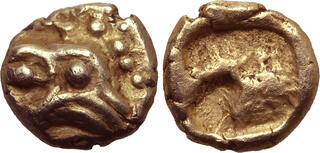| Roma Numismatics Ltd > Auction XXX | Auction date: 21 March 2024 |
| Lot number: 171 Price realized: 750 GBP (Approx. 950 USD / 875 EUR) Note: Prices do not include buyer's fees. | Show similar lots on CoinArchives Find similar lots in upcoming auctions on |
| Lot description: Thraco-Macedonian, Uncertain mint in the lower Strymon valley EL 1/48 Stater. Late 6th century BC, under Athenian influence. Owl standing to left, head facing with prominent eyes / Rough incuse square. Unpublished in the standard references; for early Macedonian electrum issues, cf. Svoronos, HPM pp. 183-91 and pl. 16, 1-24. 0.29g, 5mm. Extremely Fine. Unique and unpublished. Ex Roma Numismatics Ltd., Auction XXV, 22 September 2022, lot 296 (hammer: GBP 1,700). Coinage was introduced into the Thraco-Macedonian region, between the rivers Strymon and Nestos, in the last decades of the sixth century by the early Greek venturers and colonists. The richly wooded landscape could provide timber for shipbuilding as well as the equally attractive gold and silver of Mt. Pangeion, said to have been discovered first by the Phoenicians, then systematically mined by the local Thracian tribes. Athens in particular is well known to have enjoyed a significant income from mines of the Strymon area controlled by the tyrant Pisistratos, who after his exile in 556 BC, returned to Athens and subsequently oversaw the introduction of coinage with the unmistakable owl of Athena symbol from about 545 BC (cf. ACGC 165; HGC 4, 1603). The head facing owl became the standard reverse type of Athens from about 525 BC and during the height of the Delian League led by Athens became the most popular coin type in Asia Minor and the Persian-dominated Near East, universally as known as glaux (γλαύξ, little owl). Estimate: 1250 GBP |  |


